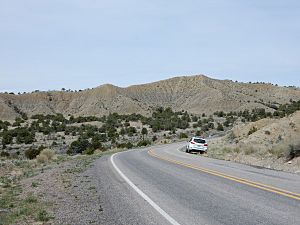Lewis Shale facts for kids
Quick facts for kids Lewis ShaleStratigraphic range: Campanian to Maastrichtian |
|
|---|---|

Hills underlain by Lewis Shale near Cuba, New Mexico.
|
|
| Type | Formation |
| Sub-units | Dad Sandstone Member, Huerfanito Bentonite Bed, Teckla Sandstone Member. |
| Underlies | Pictured Cliffs Formation |
| Overlies | Mesaverde Group |
| Thickness | 600 m |
| Lithology | |
| Primary | Shale |
| Other | Sandstone |
| Location | |
| Coordinates | 37°12′55″N 108°00′23″W / 37.2153544°N 108.0062913°W |
| Region | Mountain states, United States |
| Country | |
| Type section | |
| Named for | Fort Lewis (former Army installation in La Plata County, Colorado) |
| Named by | Charles Whitman Cross, A.C. Spencer, and C.W. Purington |
The Lewis Shale is a special type of rock layer found in the western part of the United States. It's like a big book of Earth's history! This rock layer holds clues about ancient life, including fossils from the late Cretaceous period. That was a very long time ago, when dinosaurs roamed the Earth!
Contents
What is the Lewis Shale?
The Lewis Shale is mostly an olive-gray colored rock called shale. Shale is a type of rock made from very fine mud and clay particles. It also has thinner layers of other rocks like claystone, siltstone, sandstone, and limestone.
This rock layer formed in a huge ancient ocean called the Western Interior Seaway. This sea covered much of the middle of North America during the late Cretaceous period.
You can find the Lewis Shale in several places in the western U.S. These include areas like the Bighorn Basin, Green River Basin, Powder River Basin, San Juan Basin, and Wind River Basin.
In the San Juan Basin, the Lewis Shale can be very thick. It can be over 600 meters (about 2,000 feet) thick in the northern part. But as you go south, it gets thinner and eventually disappears. This rock layer is the highest (youngest) marine shale found in this basin.
In the Green River Basin, the Lewis Shale is also very thick, up to 600 meters. Here, it's divided into two main shale parts, with a layer of sandstone called the Dad Sandstone Member in between them.
Ancient Life: Fossils in the Lewis Shale
The Lewis Shale doesn't have a huge amount of fossils. But it does contain some interesting ones! Scientists have found fossils of ancient sea creatures called ammonites. Ammonites were like squid living inside a coiled shell, similar to a modern-day nautilus.
Some of the ammonites found here include Baculites clinolobatus, Baculites asper, and Rhaeboceras. These fossils help scientists understand what life was like in the ancient Western Interior Seaway.
Natural Gas from Lewis Shale
The Lewis Shale in the San Juan Basin has been a small source of natural gas for many years. Natural gas is an important energy source that we use for heating homes and generating electricity.
Recently, there's been more interest in getting more natural gas from this rock layer. This is done using a method called hydraulic fracturing, often called "fracking." This process involves pumping water, sand, and chemicals into the rock to create tiny cracks. These cracks allow the natural gas trapped in the shale to flow out more easily.
Before 1990, only a few natural gas wells were drilled into the Lewis Shale. But by 1997, over 100 wells had been completed, showing the growing interest in this energy source.
How the Lewis Shale Got Its Name
The Lewis Shale was first named by two geologists, Charles Whitman Cross and A.C. Spencer. They named it in 1899. They chose the name because of the rock layers they studied near a place called Fort Lewis in Colorado.
Images for kids
-
Hills underlain by Lewis Shale near Cuba, New Mexico



